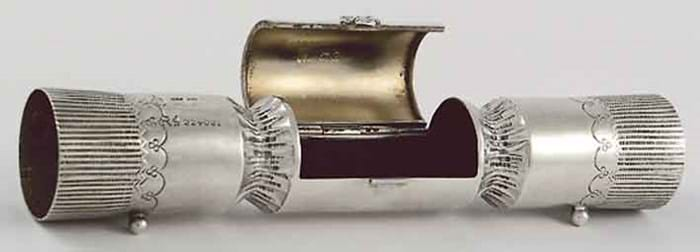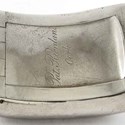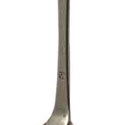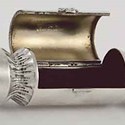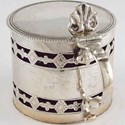The few pieces displaying exceptional artistry or the marks of hallowed silversmiths still provoke passion and acquisitiveness, but the traditional market for straightforward domestic flatware and hollowware looks tired against the energy exerted by collectors competing for silver novelties and rare provincial pieces.
"The standard middle market is not there any more," said Alexis Butcher, silver specialist and director at Woolley & Wallis. "People are shying away from displaying silver so don't want formal pieces, and no longer use silver domestic ware in the same way that they used to because of the upkeep."
Fortunately, plenty of that desirable niche market material featured in the Salisbury rooms' October 19 silver sale and ensured a very good overall performance. The fresh-to-market private collections included the second 35-lot tranche of a collection of nutmeg graters as well as a good selection on early spoons and the Fauconberg & Conyers Heirlooms.
Irish Silver
The allure of Irish provincial silver is pretty reliable and the more obscure its origins the better. For example, the same spoon with a London mark might fetch £30, one from Dublin £60-80, one from the city of Cork, £600-800, depending on the maker.
The Cork (or possibly Limerick) provenance of a 3in (8cm) long snuffbox, stamped Sterling, dating from 1800-1810 and inscribed Pat Riordan Cork, also ignited plenty of interest at the Woolley & Wallis sale, although the absence of a maker's mark put a few off.
The oblong box with concealed hinge cover was curved to fit snugly in a waistcoat pocket - an ergonomic design often also employed by Birmingham silversmiths. It sold to a collector at £2200 (estimate £600-800).
Outstanding among the spoons was an 8in (20cm), 1.5oz Irish example in the Hanoverian style (which arrived in Ireland around 1710), with a prominent rib and plain rat-tail, marked with a W and initialled HC. It was made c.1720-30 by either William Wall (d.1736) or his brother Joseph (d.1734), silversmiths from the small town of Kinsale in County Cork.
Woolley & Wallis took £3000 for a similar spoon by the same makers on June 28, 2000. Against that price, the £600-800 estimate on this October version was, to say the least, conservative.
But one could argue that, although this second example was rare, it was not unique, and that the major big-spending collector who bought the first spoon five years ago was unlikely to compete and push the price up.
Mr Butcher was delighted, but not surprised, by the many bidders in the room and on the telephones, one of whom eventually bid £5000 for the spoon.
Tortoise Bell
Novelties attracted attention as always, and included a mounted table or reception bell in the form of a 5.75in (15cm) long tortoise by Grey & Co, Chester 1912.
If a whole auction can be sustained by the theme of frogs, as it was at Kidson-Trigg back in September (see ATG No 1710, p.21), then logical evaluation of collecting habits would suggest that reptiles, like tortoises, must also have their aficionados.
In the event, it was mainly dealers who bid for it and, despite having only metal innards and underside and a thin silver shell, it sold at a double-estimate £1700.
Ring Box
A silver ring box in the form of a Christmas cracker, made by W. Gibson & J. Langman, London 1898, with incuse registration design no '324031', was as whimsical as the origin of crackers themselves.
They were invented by confectioner Tom Smith of London in 1847 as a way to market his bon-bons after a slump in sales. Smith put sweets inside a cardboard tube, wrapped them and twisted the ends of the paper. To his bon-bons he added bon mots on a slip of paper and inserted the pull popper. The cracker was born and swiftly caught on as a Victorian Christmas accompaniment.
While the romantic possibilities of a Christmas cracker ring box are obvious, the scarcity of such objects doubles the attraction, and a bid of £2300 was needed to secure the box for a dealer, well over the expected £1400-1600.
Mustard Pots
Many collectors scrutinised a private consignment of 24 mustard pots, which sold mainly above estimate.
The lowest winning bid was £90 and five examples went at between £1000 and £2100, the most expensive being a 4oz, 5in (12.5cm) high George III neoclassical urn-shaped example with pierced sides, a blue glass liner and engraved festoons, by William Stevenson, London 1782.
Perhaps more historically interesting was a George II cylindrical example by a female maker, Magdaline Feline, London 1769.
Although the goldsmiths' profession was unusual in that it did feature women, they were relatively rare and 1750-70 is also an early date for mustard pots. The 3in (8cm) high pot was fairly plain, with two pierced bands with lozenge and quatrefoil motifs and a bold shell thumb- piece. The appearance of solidity was vindicated by the weight of 5oz (the average weight of the other examples was around 3oz). Selling at £1900, it quadrupled the high estimate.
Pattern Book
Although Mr Butcher described the related literature section as 'sticky', a rare 18th century pattern book, containing designs for domestic articles of Old Sheffield plate, some of which were still used at the end of the 19th century, sold to a collector of Sheffield plate at £2100 (estimate £500-600).
The pattern book was dated to about 1790 and it was unnamed and untitled, probably so that the retailer's customers could not see who his wholesale suppliers were. Trade is trade, after all.
A 2ft 8in x 3ft 1in (82 x 94cm) framed indenture between the great silversmith Paul de Lamerie, Thomas Simmonds and Robert and Samuel Harper, dated 19th June 1741, for a property in Long Marston, Gloucestershire, made £4000. The most important parts of this document were not the details it contained but the two strong clear signatures of de Lamerie himself.
Silversmiths were often illiterate and so signatures rarely existed, with official recorders presiding over their registration. "To find one at all is unusual," said Alexis Butcher, "but to find one belonging to the greatest silversmith of the 18th century is fantastic".
The buyer's premium was 15 per cent plus VAT.



